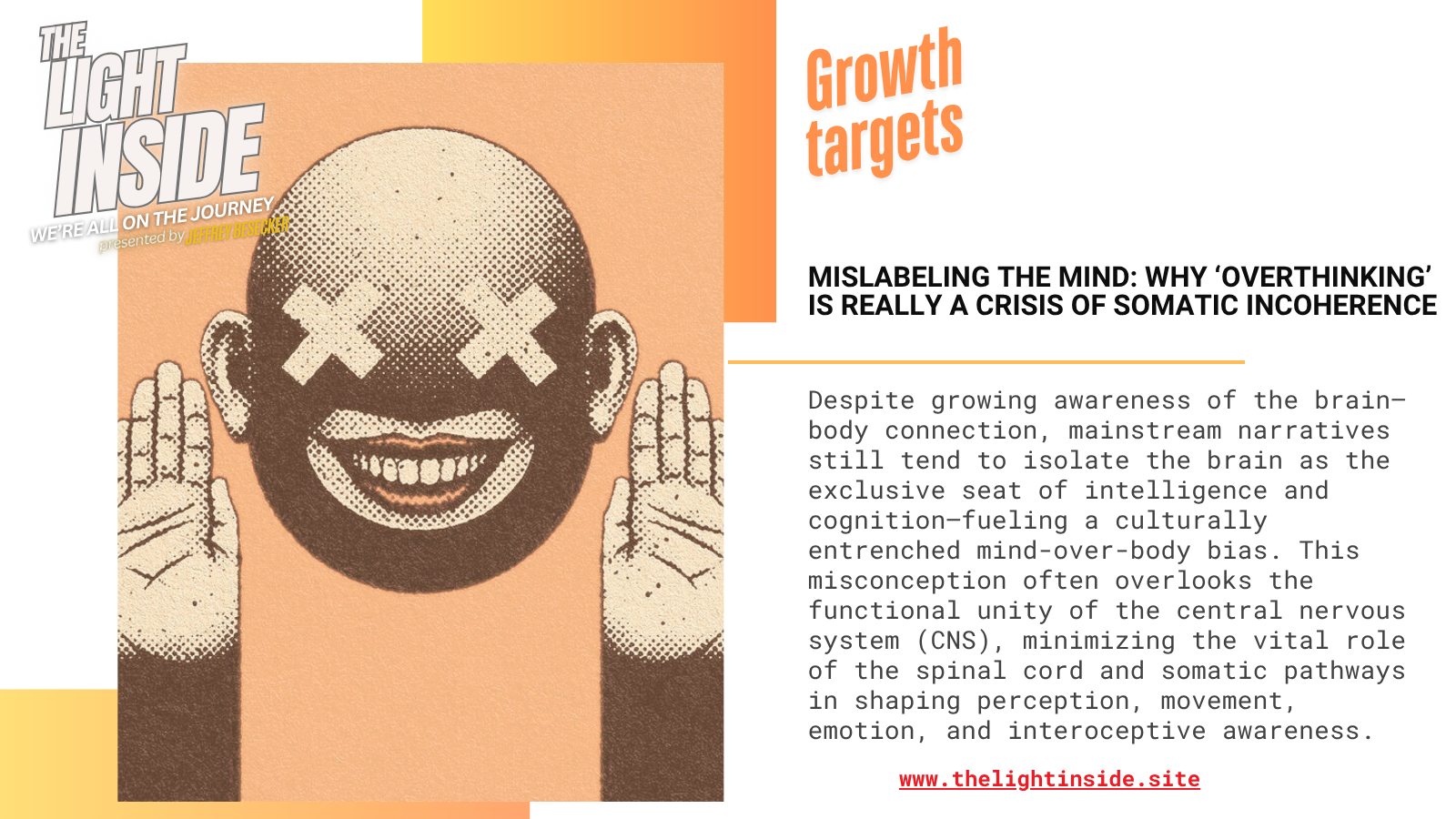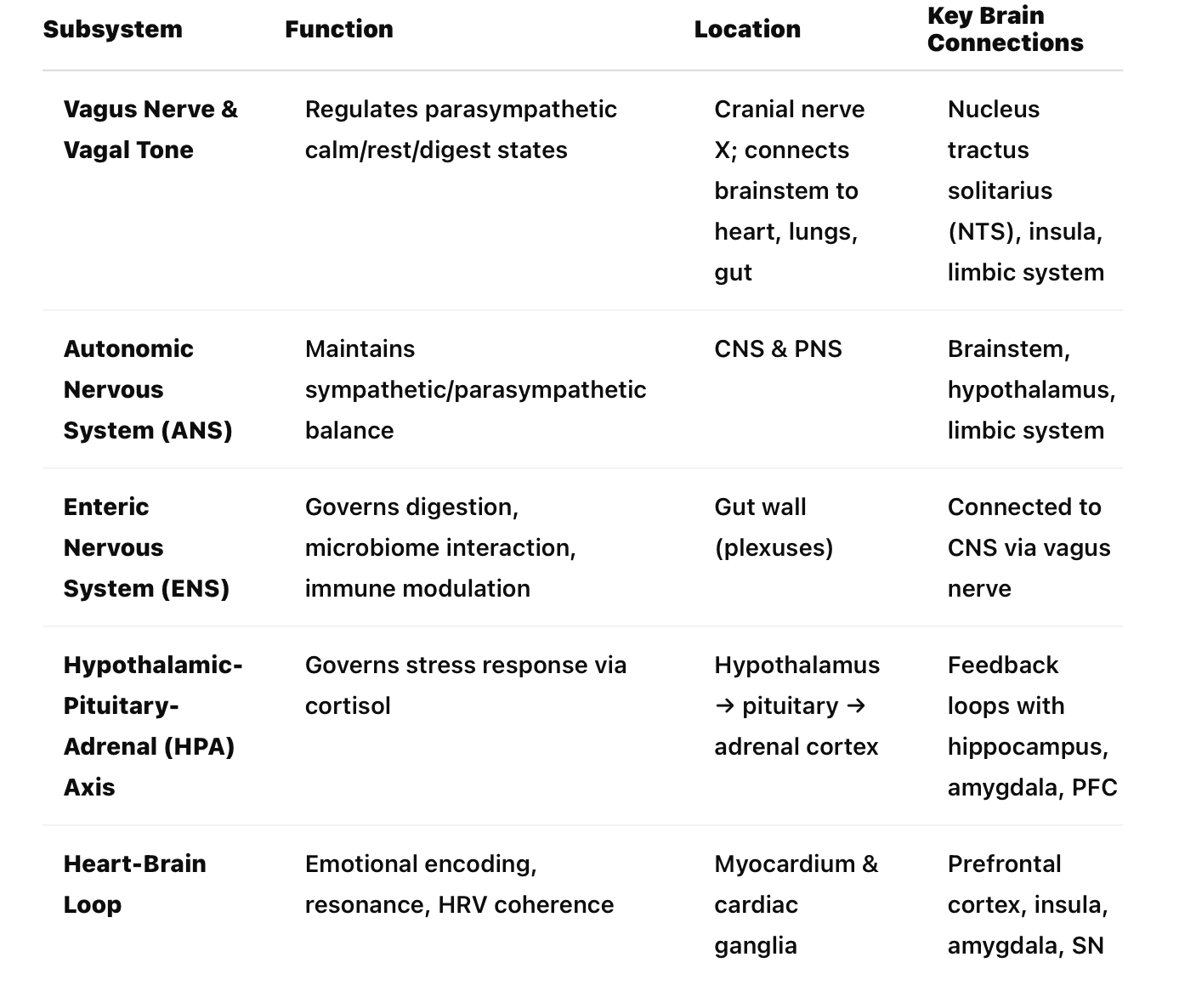Mislabeling the Mind: Why ‘Overthinking’ Is Really a Crisis of Somatic Incoherence

A Neuroanatomy Overview
In the cultural rush to unconsciously stigmatize introspection, the term “overthinking” is often misapplied—obscuring the complex neurobiological reality that many meta-cognitive loops originate not from excessive thought, but from unresolved somatic dysregulation.
This mislabeling fosters a conflicted understanding of the body–mind partnership, especially the role of somatic coherence as a key outcome of central nervous system (CNS) integration.
Rather than a purely mental glitch, what’s labeled as “overthinking” often reflects a trauma-informed feedback loop between neuroceptive misfires, salience network filtering, vagal tone modulation, and the internal narrative.
When viewed through the lens of contemporary neuroscience and somatic theory, these patterns are better understood as adaptive—but often dysregulated—neuro-somatic survival strategies seeking coherence, safety, and meaning.
Where Does The Central Nervous System Reside?
Despite growing awareness of the brain–body connection, mainstream narratives still tend to isolate the brain as the exclusive seat of intelligence and cognition—fueling a culturally entrenched mind-over-body bias. This misconception often overlooks the functional unity of the central nervous system (CNS), minimizing the vital role of the spinal cord and somatic pathways in shaping perception, movement, emotion, and interoceptive awareness.
Such fragmentation reflects a historical dualism rooted in Western self-help paradigms, which have long prioritized cerebral processes while dismissing the body’s sensory intelligence. In doing so, we obscure the neuroanatomical reality that coherence, cognition, and emotional regulation emerge from a continuous dialogue between brain, spinal cord, and the broader somatic supersystem.
Key Neuroanatomical Breakdown:
Based on current empirical data and peer-reviewed neuroscience, it's estimated that roughly 80–85% of the neurons in the central nervous system (CNS) are located within the brain—specifically in the cerebrum, cerebellum, and brainstem. The remaining 15–20% are found in the spinal cord, which acts as a relay and processing center for information between the brain and the rest of the body.
Brain (Cerebrum, Cerebellum, Brainstem):
Houses ~86 billion neurons (Azevedo et al., 2009).
The cerebellum alone contains ~80% of total brain neurons, primarily involved in fine motor coordination and sensorimotor integration.
Spinal Cord:
Contains roughly 1 billion neurons, mostly interneurons and motor neurons.
Plays a critical role in reflex arcs, autonomic regulation, and ascending/descending information pathways.
Functional Implications for the Somatic Supersystem:
The brain’s dominant neuronal share gives it a central integrative role in coordinating and regulating the somatic supersystem—which encompasses all voluntary and involuntary bodily processes governed by motor, sensory, and autonomic feedback loops.
1. Sensorimotor Regulation:
The motor cortex, somatosensory cortex, cerebellum, and basal ganglia all help initiate, adjust, and refine movements.
Their top-down control over spinal motor neurons allows for precise and adaptive movement, shaped by both internal states and external stimuli.
2. Autonomic and Visceral Integration:
The hypothalamus and brainstem nuclei (e.g., the vagus nerve nuclei) regulate:
- Heart rate
- Respiratory rhythm
- Gastrointestinal activity
These centers influence interoception—the brain’s mapping of internal bodily states—and coordinate homeostatic regulation with emotional states via the insular cortex and anterior cingulate.
3. Somatic-Sensory Feedback Loops:
Somatosensory signals from skin, joints, and muscles are processed in cortical and subcortical regions, helping the brain map bodily states (body schema) and generate conscious perception of movement and pain.
Summary: Why the Brain’s Neural Density Matters
- Because such a high percentage of the CNS’s neurons reside in the brain
The brain acts as the master coordinator, integrating input from both the spinal cord and peripheral nervous system to direct:
- Refined motor control
- Sensorial awareness
- Emotional and cognitive responses
This dense neural network supports the somatic supersystem by enabling top-down modulation, which is critical for:
Adaptive behavior
Embodied cognition
Emotion-somatic integration
Trauma response and regulation
Building on your previous inquiry—and integrating empirical neuroscience, somatic theory, and prior chat themes—the following analysis explores how the internal narrative interfaces with the salience network, autonomic and enteric subsystems, vagal function, and heart-brain dynamics to modulate somatic coherence and the perceived sense of safety. These integrated processes form a bio-psycho-social feedback system that governs neural imprinting, somatic recall, and the self-regulating coherence essential for well-being.
Cultural History Sidebar: The Myth of the Brain as the Sole Command Center
The widespread belief that the brain alone governs human thought, feeling, and behavior finds its roots in Cartesian dualism—a 17th-century philosophical framework introduced by René Descartes, which posited a strict separation between the mind and body. This reductionist view has been perpetuated throughout Western medicine and psychology, reinforcing the idea that bodily processes are secondary to cerebral “control”, rather then a joint partnsetship of emergent functions, processes, and co-regulated states, In the 20th and early 21st centuries, such dualism was subtly rebranded through the lens of pop neuroscience and commercial psychology, often relying on oversimplified or misleading models of meta-cognition.
One telling example is the Zaltman Fallacy, which originated from the work of marketing theorist Gerald Zaltman. His assertion that “95% of thought, emotion, and learning occurs in the unconscious mind” gained traction in advertising and branding circles, despite lacking rigorous neuroscientific backing.
While Zaltman’s intent was to highlight the role of implicit cognition in consumer behavior, his statement was frequently decontextualized and repurposed as fact in self-help media and popular psychology. This led to a cascade of pseudoscientific content promoting the idea of a largely inaccessible “subconscious mind” operating beneath rational awareness—detached from the somatic systems that deeply influence it.
These narratives have entrenched a cultural bias that reduces embodied cognition to mere background noise, undervaluing the critical role of the central nervous system as a distributed network—with spinal, sensory, and visceral feedback loops shaping everything from emotional regulation to decision-making.
By deconstructing these myths, we can begin to restore an integrated understanding of the body as not just a passive responder to the brain, but an active and essential co-creator of lived experience—the brain, after all, IS an integral part of the body.
- A fact often marred by meta-cognitive dissonance and willful blindness.
🧠 I. THE SALIENCE NETWORK & INTERNAL NARRATIVE: AFFECTIVE FILTERING & SOMATIC MEANING-MAKING
Understanding the distributed nature of the central nervous system sets the stage for exploring how the brain evaluates and prioritizes internal and external stimuli. At the heart of this integrative process is the salience network (SN)—a key neural system that functions not as a passive receiver of data, but as an active editor of experience.
Anchored in the anterior insula and anterior cingulate cortex, the SN acts as a neurobiological switchboard, continuously filtering streams of sensory and interoceptive information to determine what matters most in any given moment.
This moment-to-moment triaging of relevance, emotional weight, and bodily signals forms the foundation of how we assign meaning, navigate threat, and regulate adaptive behavior.
The salience network (SN)—primarily anchored in the anterior insula (AI) and anterior cingulate cortex (ACC)—acts as a neurobiological switchboard, filtering sensory and interoceptive data to assess relevance, risk, and emotional weight. This system plays a foundational role in:
- Threat detection
- Interoceptive awareness
- Switching between the default mode and executive networks
Internal narrative generation, especially how we interpret somatic and emotional experiences.
- Internal Narrative and the Fear-Sense Loop
The SN interprets body-based signals and overlays them with affective forecasting and meta-cognitive appraisals ("Why is my heart racing? Am I in danger or excited?").
This interpretation shapes the internal narrative, which then feeds back into autonomic activation—creating a biofeedback loop that can amplify or resolve dysregulation.
🧬 II. THE SOMATIC SUPER-SYSTEM: AFFERENT/ EFFERENT SIGNALING & SAFETY PERCEPTION
Afferent vs. Efferent Communication
~80–90% of vagal nerve fibers are afferent, transmitting sensory data from body to brain (Craig, 2002).
The efferent fibers influence heart rate, digestion, inflammation, and facial musculature—shaping both physiological state and emotional expression.
Key Somatic Subsystems:
🌊 III. COHERENCE, NEUROBIOLOGICAL SAFETY, & SOMATIC MEMORY
1. Somatic Coherence:
Achieved when physiological, emotional, and cognitive systems entrainharmoniously, often reflected in heart rate variability (HRV) and vagal tone.
Internal coherence: is modulated by the ability to accurately interpret afferent signals, downregulate reactivity, and re-story the narrative through cognitive-emotional reframing.
2. Neural Imprinting & Somatic Recall:
Early-life trauma or stress imprints patterns in the limbic system, insula, brainstem, and ENS, forming implicit memory traces stored somatically.
These patterns may be reactivated by salient cues (via the SN), even without conscious awareness, leading to non-verbal recall (e.g., muscle tension, gut distress, panic).
This contributes to “somatic recall”—the body remembering what the mind forgets.
🫀 IV. THE HEART’S SUBSYSTEM ROLE: A COHERENCE ANCHOR
The heart functions as both a physiological oscillator and an emotional amplifier:
Heart Rate Variability (HRV) reflects the integration of emotional and physiological regulation via vagal tone.
The cardiac afferent system sends signals to the amygdala, insula, and prefrontal cortex, influencing emotional regulation, risk detection, and decision-making.
Coherent HRV states (e.g., through breathwork, compassion, or resonance practices) modulate the salience network, reduce HPA activation, and restore narrative clarity.
🧩 V. MISSING LINKS & COMPLETING THE LOOP
1. Neuroception (Stephen Porges, Polyvagal Theory)
Subcortical scanning for safety/danger occurs below conscious awareness, influencing narrative, autonomic regulation, and social behavior.
If neuroception falsely detects threat (e.g., due to trauma), it drives dysregulation even in the absence of real danger.
Our internal narrative doesn’t just reflect experience—it actively shapes it.
When neuroceptive misfires trigger perceived threats, these signals loop into the brain’s narrative-making systems, generating recursive cognitive-emotional spirals that reinforce rumination, shame, and distorted self-appraisal—often mislabeled as mere “overthinking,” obscuring their deeper neurobiological roots.
🔁 I. Metacognitive Feedback Loops and Dysregulated Neuroception
Here's a detailed analysis that connects the quote—“If neuroception falsely detects threat (e.g., due to trauma), it drives dysregulation even in the absence of real danger”—to rumination, shame spirals, circular reasoning, and meta-cognitive feedback loops, while critiquing the use of the term “overthinking” as both stigmatizing and neurobiologically reductive.
Neuroception and Cognitive Feedback Loops
When neuroception—the subconscious detection of safety or threat via the autonomic nervous system—misfires due to unresolved trauma or conditioned hypervigilance, it introduces a bottom-up error signal that is interpreted by cortical systems as significant. This error then loopsinto higher-order processing systems like the salience network, default mode network (DMN), and executive control networks—amplifying cognitive-emotional noise.
This creates a meta-cognitive feedback loop:
- The body feels unsafe (neuroceptive misfire).
- The mind interprets this through the internal narrative: “Something must be wrong.”
- The brain’s salience network flags this as important.
- This elevates autonomic arousal and limbic activation.
These arousal cues feed back into the narrative (“I knew I couldn’t relax”), reinforcing the cycle.
This loop isn’t “overthinking” in a voluntary or cognitive sense—it’s a neuro-somatic misattribution.
🧠 II. Rumination and Shame Spirals as Neurobiological Artifacts
When the DMN is left unchecked—often due to reduced prefrontal inhibition during stress—it shifts from adaptive introspection to ruminative self-focus:
- Neuroceptive errors drive ambiguous or negative appraisals.
These appraisals enter recursive loops within the internal narrative: “Why am I like this? What’s wrong with me?”
This reactive introspection activates limbic structures like the amygdala and subgenual anterior cingulate, fueling feelings of shame, hopelessness, or existential threat.
This is not “overthinking” in the popular sense. It’s affectively hijacked cognitive looping—driven by faulty interoceptive prediction models (cf. Friston’s predictive coding theory).
🧩 III. Why “Overthinking” Is a Misnomer
Labeling these dynamics as “overthinking”:
- Stigmatizes internal vigilance that is actually adaptive when understood in a trauma-informed context.
- Dismisses the somatic origin of many cognitive loops.
- Obscures the role of implicit memory, cultural scripts, and autonomic misattunement.
Stigmatizing emotional sensitivity, somatic awareness, and trauma symptomatology—especially in BIPOC, neurodivergent, and gender-marginalized individuals, where cultural epistemic suppression is already high.
- The term suggests an excess of thought, when the issue is unresolved somatic distress being interpreted as cognitive content.
🔄 IV. Circular Reasoning as a Defensive Cognitive Strategy
When neuroception is dysregulated:
The brain seeks explanatory closure for body-based sensations it cannot categorize.
- This promotes circular reasoning—e.g., “I’m anxious because I’m weak. I’m weak because I’m anxious.”
- This is a maladaptive meaning-making loop, not a logical flaw.
- It serves to contain uncertainty, even if the narrative is damaging.
These feedback loops anchor a false sense of control in the midst of biological dysregulation.
🔬 V. Integrative Synthesis within the Current Document
The document’s section on the salience network, vagal tone, somatic recall, and narrative formation provides a direct neurobiological explanation for why these loops are so persistent and distressing:
- The salience network flags dysregulated signals as high priority.
- The vagal nerve’s afferent signals inform narrative content.
- Somatic recall recreates the emotional body state of past trauma, which then colors present-day interpretations.
- The internal narrative constructs meaning from this misattunement, shaping beliefs, identity, and behavioral responses.
Labeling all this as “overthinking” bypasses the actual neurobiological and somatic processes involved—and enforces a cultural demand for cognitive neatness over emotional and bodily integration.
✅ Final Framing:
Rather than “overthinking,” these are somatically initiated metacognitive survival strategies caught in recursive loops—best understood as a neuro-somatic narrative process. Addressing them requires:
- Restoring vagal tone and interoceptive accuracy,
- Reframing internal narrative through trauma-informed dialogue,
- Reducing cognitive shame through social compassion and epistemic curiosity.
2. Insular Cortex Integration
The posterior insula maps interoceptive signals; the anterior insula integrates them into emotional context and awareness.
Dysfunction here can lead to alexithymia, misattunement to bodily states, and dissociation—further fragmenting coherence.
3. Cultural/Epistemic Imprints
Learned suppression of emotion, cultural scripts, and epistemic dissonance distort internal narrative and contribute to false coherence or chronic dissociation (e.g., "I'm fine" masking internal chaos).
SUMMARY: INTEGRATED MODEL
The salience network decides what matters.
The internal narrative creates meaning around body signals.
The vagus nerve and ANS modulate safety responses.
The enteric and cardiac subsystems feed emotional and physiological feedback into cognitive frameworks.
The HPA axis enacts longer-term hormonal responses to stress, reinforcing neural and somatic memory loops.
These interconnected systems encode, recall, and narrate our lived somatic experience, forming the basis of identity, emotional regulation, and trauma recovery.
Closing Statement:
When we pause to recognize that what we often call “overthinking” is, in truth, a deeply intelligent—though sometimes dysregulated—attempt by the brain and body to keep us safe, we begin to shift from judgment to compassion. These cognitive and somatic loops are not flaws to fix, but adaptive strategies shaped by our lived experiences, seeking coherence, stability, and healing. So go easy on your brain. Go gently with your body. They’re not broken—they’re doing their best to create a safe and hospitable space for your continued existence.
Call to Action:
If this resonates with you, join us on The Light Inside as we explore the hidden architecture of our minds—diving into the unresolved psychological data and the primary and secondary patterns that shape our thoughts, behaviors, and emotional worlds.
Tune in for grounded insights, science-informed dialogue, and compassionate tools for greater self-awareness and embodied healing.




